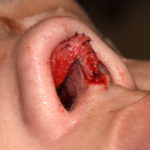By far, the most challenging aspect of rhinoplasty surgery is in the nasal tip. As the nasal tip is probably the greatest variable in appearance amongst individuals and one of the most defining parts of the nose, precision in nasal tip changes during rhinoplasty is of critical importance. Therefore, good access to provide adequate visualization and workability of the nasal tip cartilages is key.
Rhinoplasty, by its history, has been traditionally done through a closed or endonasal delivery technique. By this approach, the nasal tip cartilages are delivered without using a skin incision at the columella. In the ‘right’ nose, I personally prefer this technique as it is simple, produces consistent results, and has a low rate of the need for revisional surgery. It also offers the bonus of less prolonged swelling of the nasal tip after rhinoplasty. Good patients are those that have fairly thin nasal skin, strong stiffer cartilages, and have never had rhinoplasty surgery before. The only problem with the closed approach to rhinoplasty is that it requires more finesse in delivering and suturing the cartilages than an open approach.

The debate between open vs. closed rhinoplasty isn’t really a debate anymore. It is more about what type of nose does a patient have and the plastic surgeon’s experience with each rhinoplasty technique.
Dr. Barry Eppley
Indianapolis, Indiana


